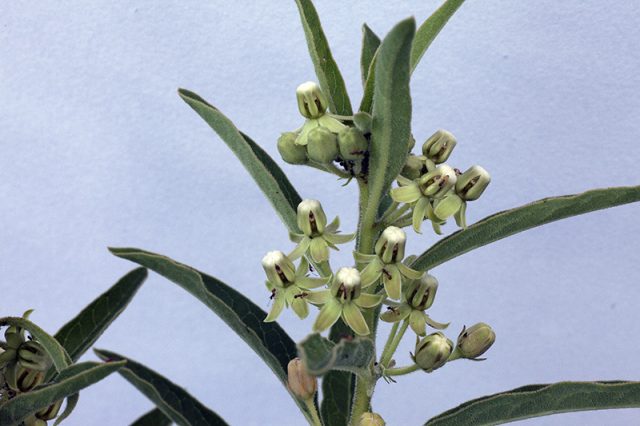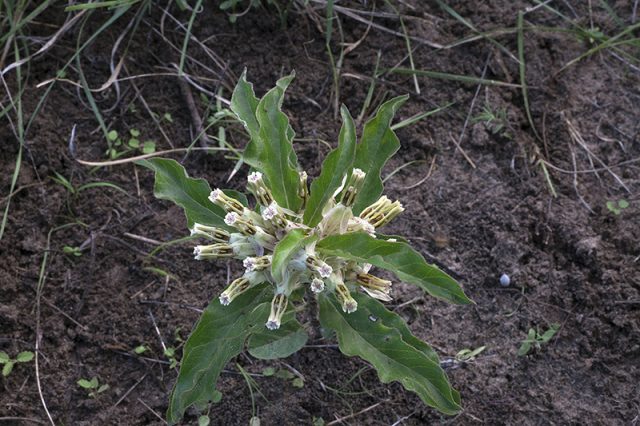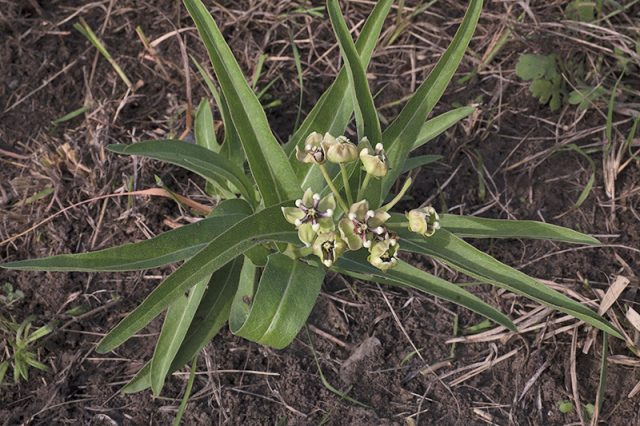
This stake marks the location of one of the Zizotes Milkweeds we found in our pasture. We initially flagged 18 milkweeds in an area of just four acres. Later, we located 28 more plants in the same area. Robert Benson Photo.
16 Sep 2016 – Will the Real Zizotes Please Stand Up?
Our pasture is nice and green, in fact, surprisingly so for early September. All those thunderstorms this past month have really greened things up. It is time for fall wildflowers, like liatris and gerardia, to show up among the grasses. Recently, I ambled across the pasture looking for signs of these purplish flowers. Instead, I found dull green plants with odd whitish blossoms: milkweeds!
But what kind of milkweeds were these? They did not look anything like the Green Antelope Horns I usually see. These new milkweeds were scarcely a foot tall and rather scraggly. I wondered how many there were. We decided to drive ten-foot wide swaths back and forth across the pasture. I leaned out of the buggy, searching for the fuzzy leaves and distinctive inflorescences of the milkweeds. We flagged eighteen plants!
I was elated. I hoped these were the south Texas native milkweeds called “Zizotes.” A master naturalist had shown me a specimen of one once, but I promptly forgot what it looked like. I checked the images on the Internet and thumbed through the wildflower books. Zizotes was a possibility.

Emory’s Milkweed has rather narrow leaves and whitish flowers. Its flowers have shorter hoods than Zizote’s flowers. Notice that the tops of the hoods seem to be closed off and blunt. Robert Benson Photo.
We had to get samples of the flowers and leaves. I knew we needed to measure and work our way through the Key to Milkweeds to identify our plants. Hours later, after pulling apart flowers under magnification, measuring the length of the “hoods,” examining the amount of hairiness on the leaves, and looking up endless botanical terms like repand, decussate, and umbelliformly cymose, we decided we did indeed have Zizotes. As well as some other milkweed species that looked a whole lot like it!
To identify milkweeds, you must first familiarize yourself with the incredible flower structure of these plants. In the bud stage, five leaf-like sepals cover each flower. When opened the sepals fold backwards forming a five-pointed ring around the base of the bloom. Above the ring of sepals there is another ring with five petals. This is the corolla. Set inside the corolla are the sexual parts of the flower: the stamens that produce the pollen and the ovary containing the plant’s ovules. However, in the milkweeds, all of the sexual parts are fused into a column with five hood-like structures sticking up in a star-shaped ring. The hoods produce nectar to reward pollinators for visiting. Between the hoods are openings into which a pollinator may deposit pollen.

Zizotes Milkweed is a rather plain milkweed but it is still valuable as a larval food for Monarch Butterflies. Look closely at the flowers. You will see that the flower’s hoods are yellow and stick up above the center of the flower. Robert Benson Photo.
So far so good: this is not too different from what happens in most flowers. Milkweeds, however, go a step further. They transfer their pollen in a pair of waxy packets called pollinia. The pollinia are at the ends of a wishbone-shaped structure attached to the column between the hoods. A visiting insect catches its leg on the threadlike arms of the structure. It must pull and pull. If it succeeds in pulling out the packets and then visits another flower, it just might wedge one of the pollinia into the opening leading to the ovules of that flower. Maybe. Or maybe not. It is all very “iffy.” Perhaps this complex form of pollination is why we see so few milkweed seedpods.
Let’s go back to our pasture and its milkweeds. Zizotes (Asclepias oenotheroides) differs from similar milkweeds primarily by the height of the hoods. Zizotes hoods are yellow and they stick up above the sexual column in the center of the flower. Looking down on the flower you can see that the hoods are open at the top. The other milkweed in our pasture had shorter, blunter, closed-off tops to its hoods. This plant is Emory’s Milkweed (Asclepias emoryi).
Why all this fuss over milkweeds, you ask? As you probably know, Monarch Butterflies are in trouble. Some experts claim that their population is down 90%. Milkweeds are the larval food for Monarchs. There is a strong conservation effort going on to preserve milkweeds all along the butterflies’ migration route to Mexico. Every milkweed counts.

Green Antelope Horns is another species of milkweed we sometimes find in south Texas. Notice the purple star-shaped structures in the center of the flowers. Robert Benson Photo.
To help people identify milkweeds, especially the not-so-showy native species, Texas Parks and Wildlife has published an online guide. This Identification to the Milkweeds (Asclepias, Family Apocynaceae) of Texas describes 37 species of milkweed that grow in Texas. Of course, differ species have different habitat preferences, so you cannot expect to find them all in south Texas. Zizotes, Emory’s Milkweed, Green Antelope Horns, and Slim Milkweed are the most likely to survive our dry caliche soils.
The name “zizotes” is peculiar. I looked it up in the biggest Spanish/English dictionary I could find. No zizotes found. The Urban Dictionary online translates it as “ringworm.” A couple of Spanish medical websites hinted that it should be spelled “sisotes” or even “jiotes” and that these referred to skin blemishes (maybe ringworm?). Perhaps the “ring” of hoods in the center of the blossom accounts for this name.
But don’t take my word for it. Get out there and find your own Zizotes or other milkweeds. They are all well worth a good look!
If you would like to offer comments, please click through to the discussion page
